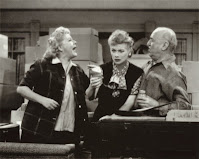A century ago this month, what became the most
structured—and successful—studio in Hollywood’s Golden Age was formed with the
merger of Metro Pictures Corp., Goldwyn Pictures and Louis B. Mayer
Productions.
Though theater chain magnate Marcus Loew orchestrated
the deal, the prime mover for the next 27 years in Metro-Goldwyn-Mayer—MGM for
short—turned out to be a Ukrainian emigrant who not only celebrated American
values onscreen, but even pushed his actual birthdate up to July 4 to coincide
with that of his adopted country.
In his office in Culver City, studio head Louis B. Mayer may not have been the most hated movie mogul (that dishonor probably
goes to Jack L. Warner), but he was the most paternalistic—an executive you
wanted on your side and dreaded to cross.
Those in “L.B.”’s lair might find themselves subject
to shouting (MGM president Nicholas Schenck, who, upon Loew’s death, dealt with
the theater side of the business from New York), groping (young musical star
Judy Garland, who, according to notes for an unpublished memoir, claimed she finally summoned the nerve to tell him to stop), and crying (matinee idol
Robert Taylor, who, after having his boss cry on his shoulders, gave up his
demand for more money).
Directors might fume at rushed production schedules,
favorite scenes left on the cutting-room floor, or being replaced
mid-production.
But all of these C-suite theatrics produced as many as
50 films a year, including Gone With the Wind, all-star vehicles like
the Oscar-winning Grand Hotel, beloved musicals such as The Wizard of
Oz —and, in 1937, in the midst of the Great Depression, a princely yearly
salary of $1.3 million for Mayer.
The roaring lion appearing at the start of its films
may have been MGM’s most instantly recognizable branding element, but its most
important asset was its stable of actors.
“More Stars Than There Are in Heaven,” the studio’s
advertising slogan went—a boast that held true from the silent era (e.g., Greta
Garbo, Jack Gilbert, Buster Keaton, Lon Chaney) well into the coming of sound
(Clark Gable, Myrna Loy, Jean Harlow, Gene Kelly).
The Culver City complex was a true movie
factory—“scattered over six separate lots, cramped and shedded and separated
from one another by public thoroughfares,” with Lot 1 given over to stages dressing rooms, and offices, according to James Curtis’ 2011 biography of the studio’s most respected actor, Spencer Tracy.
Here, stars were manufactured virtually from whole
cloth (Lana Turner, Ava Gardner), shrewdly redesigned when found to be
imperfect elsewhere (Tracy, Wallace Beery, and Marie Dressler); or imported
from Europe (Garbo and Hedy Lamarr).
It all stemmed from Mayer’s frequently expressed
belief that the movies were the only business where the assets walked out the
gate every night, and Thalberg’s understanding that “without stars, a company
is in the position of starting over every year.”
And, long before Hollywood went endlessly to the well
with the “Star Wars” and Marvel series, MGM milked the commercial value of
multi-film franchises, including:
*The 12 Tarzan movies made by Johnny Weissmuller from
1932 to 1948;
*The six “Thin Man” movies starring William Powell and
Myrna Loy;
*The nine Doctor Kildare movies made by Lew Ayres;
* Mickey Rooney’s 15 “Andy Hardy” films from 1937 to
1946;
*The 10 “Maisie” comedies with Ann Sothern as a
lovable Brooklyn showgirl; and
* The “aqua-musicals” of “America’s Mermaid,” Esther
Williams.
Several Mayer lieutenants were crucial in churning out
all this product:
* Irving Thalberg: Nicknamed
the “Boy Wonder” by the press and “The Last Tycoon” by F. Scott Fitzgerald (who
fictionalized him as the title character of his posthumously published
Hollywood novel), he served as production head of the new studio and a kind of
surrogate son to Mayer, before dying of pneumonia, after a dozen years of
overwork as the epitome of a Hollywood creative producer, at age 37.
* Eddie Mannix:
Installed
as a studio snitch by Nicholas Schenck, he soon went over to Mayer’s side, where,
as general manager, he became LB’s indispensable “fixer”—soothing insecure
stars, along with squelching innumerable scandals involving pregnancies, fatal
auto accidents, abortions, a precursor of Harvey Weinstein's sexual harassment crimes—and, some have argued, the murder of “Three Stooges”
director Ted Healy.
* Howard Strickling: Head
of publicity, the studio exec in charge of communication was, ironically,
afflicted with a communication handicap of his own—stuttering. But, 24/7, he
controlled access to the industry’s greatest assembly of talent, rewarding
reporters who played ball and punishing those who didn’t.
* Howard Dietz: Head
of advertising and publicity at the studio for 30 years, he not only came up
with its famous lion (an idea he borrowed from the mascot of his alma mater, Columbia
University), but also pursued a simultaneous sideline as the lyricist partner
of Arthur Schwartz.
The landmark 1948 Supreme Court case United States v. Paramount effectively ended the quarter century of studio dominance by
outlawing the block-booking system of selling multiple films to a theater as a
unit and by recommending the breakup of studio-theater monopolies.
Three years later, Nicholas Schenck finally resolved
his multi-decade clash with Mayer by persuading the studio’s board of directors
to replace the mogul with writer-producer Dore Schary, who would suffer the same fate
as his predecessor five years later.
By
the 1960s, MGM’s onetime ability to achieve profit margins even with handsomely
mounted productions had devolved into boom-or-bust blockbusters that left it vulnerable
to takeovers. It’s now a subsidiary of Amazon.

























